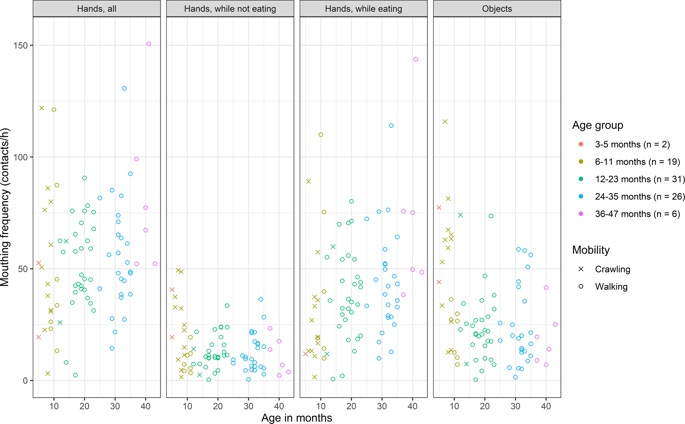当前位置:
X-MOL 学术
›
J. Expo. Sci. Environ. Epid.
›
论文详情
Our official English website, www.x-mol.net, welcomes your
feedback! (Note: you will need to create a separate account there.)
Age-related changes to environmental exposure: variation in the frequency that young children place hands and objects in their mouths.
Journal of Exposure Science and Environmental Epidemiology ( IF 4.1 ) Pub Date : 2019-08-05 , DOI: 10.1038/s41370-019-0115-8 Laura H Kwong 1 , Ayse Ercumen 2, 3 , Amy J Pickering 4 , Leanne Unicomb 5 , Jennifer Davis 1, 6 , Stephen P Luby 6
Journal of Exposure Science and Environmental Epidemiology ( IF 4.1 ) Pub Date : 2019-08-05 , DOI: 10.1038/s41370-019-0115-8 Laura H Kwong 1 , Ayse Ercumen 2, 3 , Amy J Pickering 4 , Leanne Unicomb 5 , Jennifer Davis 1, 6 , Stephen P Luby 6
Affiliation

|
Children are exposed to environmental contaminants through direct ingestion of water, food, soil, and feces, and through indirect ingestion owing to mouthing hands and objects. We quantified ingestion among 30 rural Bangladeshi children < 4 years old, recording every item touched or mouthed during 6-hour video observations that occurred annually for 3 years. We calculated the frequency and duration of mouthing and the prevalence of mouth contacts with soil and feces. We compared the mouthing frequency distributions to those from US children to evaluate the appropriateness of applying the US data to the Bangladeshi context. Median hand-mouthing frequency was 43-72 times/h and object-mouthing frequency 17-34 times/h among the five age groups assessed. For half of the observations, > 75% of all hand mouthing was associated with eating. The frequency of indoor hand mouthing not related to eating was similar to the frequency of all indoor hand mouthing among children in the United States. Object-mouthing frequency was higher among Bangladeshi children compared with US children. There was low intra-child correlation of mouthing frequencies over our longitudinal visits. Our results suggest that children's hand- and object-mouthing vary by geography and culture and that future exposure assessments can be cross-sectional if the goal is to estimate population-level distributions of mouthing frequencies. Of all observations, a child consumed soil in 23% and feces in 1%.
中文翻译:

环境暴露的年龄相关变化:幼儿将手和物体放入口中的频率变化。
儿童通过直接摄入水、食物、土壤和粪便,以及通过嘴巴手和物体间接摄入环境污染物而暴露于环境污染物中。我们量化了 30 名 4 岁以下的孟加拉国农村儿童的摄入量,记录了在 3 年内每年发生的 6 小时视频观察中触摸或嘴巴的每一个项目。我们计算了张嘴的频率和持续时间以及口腔与土壤和粪便接触的发生率。我们将嘴巴频率分布与美国儿童的嘴巴频率分布进行比较,以评估将美国数据应用于孟加拉语境的适当性。在所评估的五个年龄组中,中位说手频率为 43-72 次/小时,中位说物体频率为 17-34 次/小时。对于一半的观察结果,> 75% 的所有用手开口与进食有关。与进食无关的室内用手咬嘴频率与美国儿童在室内用手咬嘴的频率相似。与美国儿童相比,孟加拉儿童的口头表达频率更高。在我们的纵向访问中,口语频率的儿童内部相关性较低。我们的研究结果表明,儿童的嘴巴和物体的嘴巴因地理和文化而异,如果目标是估计嘴巴频率的人口水平分布,则未来的暴露评估可以是横截面的。在所有观察中,儿童消耗土壤的比例为 23%,粪便的比例为 1%。与美国儿童相比,孟加拉儿童的口头表达频率更高。在我们的纵向访问中,口语频率的儿童内部相关性较低。我们的研究结果表明,儿童的嘴巴和物体的嘴巴因地理和文化而异,如果目标是估计嘴巴频率的人口水平分布,则未来的暴露评估可以是横截面的。在所有观察中,儿童消耗土壤的比例为 23%,粪便的比例为 1%。与美国儿童相比,孟加拉儿童的口头表达频率更高。在我们的纵向访问中,口语频率的儿童内部相关性较低。我们的研究结果表明,儿童的嘴巴和物体的嘴巴因地理和文化而异,如果目标是估计嘴巴频率的人口水平分布,则未来的暴露评估可以是横截面的。在所有观察中,儿童消耗土壤的比例为 23%,粪便的比例为 1%。
更新日期:2019-11-18
中文翻译:

环境暴露的年龄相关变化:幼儿将手和物体放入口中的频率变化。
儿童通过直接摄入水、食物、土壤和粪便,以及通过嘴巴手和物体间接摄入环境污染物而暴露于环境污染物中。我们量化了 30 名 4 岁以下的孟加拉国农村儿童的摄入量,记录了在 3 年内每年发生的 6 小时视频观察中触摸或嘴巴的每一个项目。我们计算了张嘴的频率和持续时间以及口腔与土壤和粪便接触的发生率。我们将嘴巴频率分布与美国儿童的嘴巴频率分布进行比较,以评估将美国数据应用于孟加拉语境的适当性。在所评估的五个年龄组中,中位说手频率为 43-72 次/小时,中位说物体频率为 17-34 次/小时。对于一半的观察结果,> 75% 的所有用手开口与进食有关。与进食无关的室内用手咬嘴频率与美国儿童在室内用手咬嘴的频率相似。与美国儿童相比,孟加拉儿童的口头表达频率更高。在我们的纵向访问中,口语频率的儿童内部相关性较低。我们的研究结果表明,儿童的嘴巴和物体的嘴巴因地理和文化而异,如果目标是估计嘴巴频率的人口水平分布,则未来的暴露评估可以是横截面的。在所有观察中,儿童消耗土壤的比例为 23%,粪便的比例为 1%。与美国儿童相比,孟加拉儿童的口头表达频率更高。在我们的纵向访问中,口语频率的儿童内部相关性较低。我们的研究结果表明,儿童的嘴巴和物体的嘴巴因地理和文化而异,如果目标是估计嘴巴频率的人口水平分布,则未来的暴露评估可以是横截面的。在所有观察中,儿童消耗土壤的比例为 23%,粪便的比例为 1%。与美国儿童相比,孟加拉儿童的口头表达频率更高。在我们的纵向访问中,口语频率的儿童内部相关性较低。我们的研究结果表明,儿童的嘴巴和物体的嘴巴因地理和文化而异,如果目标是估计嘴巴频率的人口水平分布,则未来的暴露评估可以是横截面的。在所有观察中,儿童消耗土壤的比例为 23%,粪便的比例为 1%。











































 京公网安备 11010802027423号
京公网安备 11010802027423号